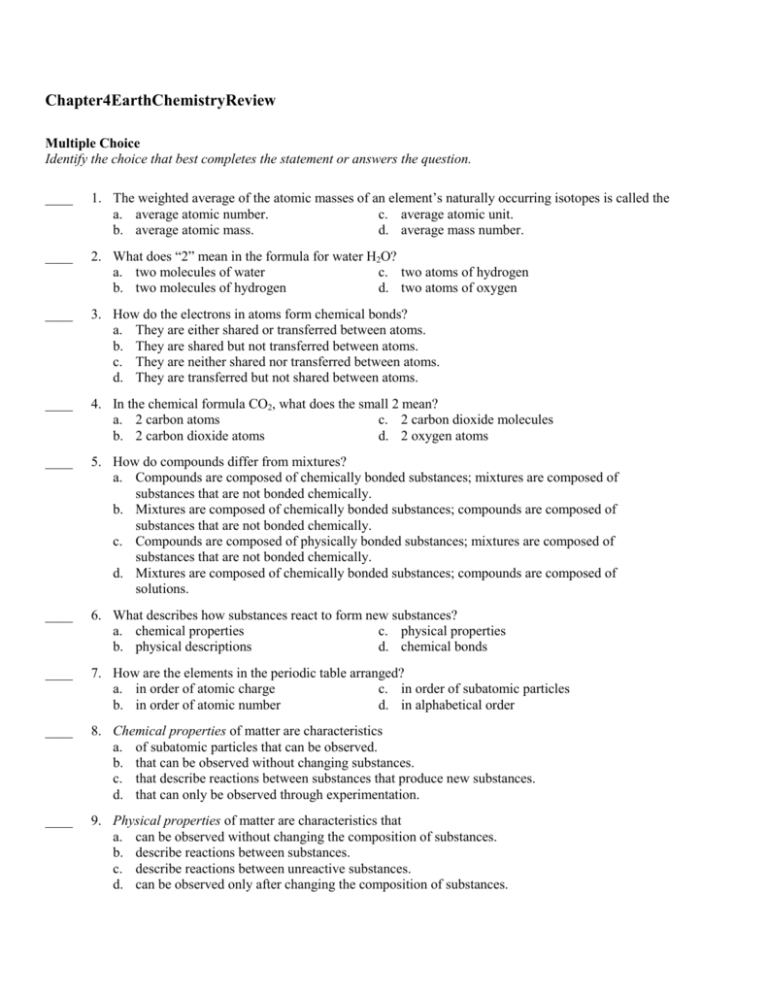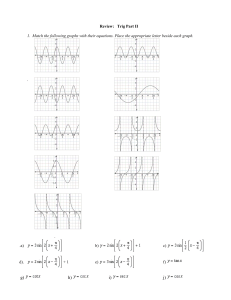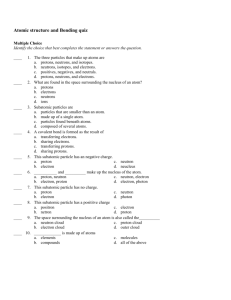Chapter 4 Review Test
advertisement

Chapter4EarthChemistryReview Multiple Choice Identify the choice that best completes the statement or answers the question. ____ 1. The weighted average of the atomic masses of an element’s naturally occurring isotopes is called the a. average atomic number. c. average atomic unit. b. average atomic mass. d. average mass number. ____ 2. What does “2” mean in the formula for water H2O? a. two molecules of water c. two atoms of hydrogen b. two molecules of hydrogen d. two atoms of oxygen ____ 3. How do the electrons in atoms form chemical bonds? a. They are either shared or transferred between atoms. b. They are shared but not transferred between atoms. c. They are neither shared nor transferred between atoms. d. They are transferred but not shared between atoms. ____ 4. In the chemical formula CO2, what does the small 2 mean? a. 2 carbon atoms c. 2 carbon dioxide molecules b. 2 carbon dioxide atoms d. 2 oxygen atoms ____ 5. How do compounds differ from mixtures? a. Compounds are composed of chemically bonded substances; mixtures are composed of substances that are not bonded chemically. b. Mixtures are composed of chemically bonded substances; compounds are composed of substances that are not bonded chemically. c. Compounds are composed of physically bonded substances; mixtures are composed of substances that are not bonded chemically. d. Mixtures are composed of chemically bonded substances; compounds are composed of solutions. ____ 6. What describes how substances react to form new substances? a. chemical properties c. physical properties b. physical descriptions d. chemical bonds ____ 7. How are the elements in the periodic table arranged? a. in order of atomic charge c. in order of subatomic particles b. in order of atomic number d. in alphabetical order ____ 8. Chemical properties of matter are characteristics a. of subatomic particles that can be observed. b. that can be observed without changing substances. c. that describe reactions between substances that produce new substances. d. that can only be observed through experimentation. ____ 9. Physical properties of matter are characteristics that a. can be observed without changing the composition of substances. b. describe reactions between substances. c. describe reactions between unreactive substances. d. can be observed only after changing the composition of substances. ____ 10. Mixtures in which two or more substances are uniformly dispersed are called a. suspensions c. saturations b. solutions d. supersaturations ____ 11. When figuring out atomic mass, the mass of what subatomic particle is ignored? a. proton c. electron b. neutron d. isotope ____ 12. What are the main subatomic particles in the nucleus of an atom? a. protons c. protons and neutrons b. neutrons d. protons and electrons ____ 13. What is the atomic number of an element represent? a. protons c. electrons b. neutrons d. protons and neutrons ____ 14. What is the mass number of an element represent? a. protons c. electrons b. neutrons d. protons and neutrons ____ 15. What makes an isotope different from other atoms of the same element? a. number of protons c. number of electrons b. number of neutrons d. number of protons and neutrons ____ 16. A molecule can be described as... a. two or more different atoms chemically combined b. two or more atoms chemically combined c. two or more different atoms physically combined d. two or more atoms physically combined ____ 17. A compound can be described as..... a. two or more different atoms chemically combined b. two or more atoms chemically combined c. two or more different atoms physically combined d. two or more atoms physically combined ____ 18. If Hg (Mercury) has an atomic number of 80 and a mass number of 200, how many protons does it have? a. 80 c. 120 b. 200 d. 40 ____ 19. If Hg (Mercury) has an atomic number of 80 and a mass number of 200, how many neutrons does it have? a. 80 c. 120 b. 200 d. 40 ____ 20. If Hg (Mercury) has an atomic number of 80 and mass number of 200, how many electrons does it have? a. 80 c. 120 b. 200 d. 40 ____ 21. An atom that contains 9 protons, 5 neutrons, and 9 electrons has an atomic number of a. 9 c. 18 b. 14 d. 23 ____ 22. An atom that contains 9 protons, 5 neutrons, and 9 electrons has a mass number of a. 9 c. 18 b. 14 d. 23 Matching Match each item with the correct statement below. a. negatively charged subatomic particle b. characteristics that describe how a substance reacts with other substances to form new substances c. characteristics that can be observed without changing the composition of the substance d. subatomic particle without charge e. positively charged subatomic particle ____ ____ ____ ____ ____ 23. 24. 25. 26. 27. chemical properties neutron proton physical properties electron Match each item with the correct statement below. a. the smallest unit of an element that maintains all of the element’s chemical properties b. two or more substances that are not combined chemically c. a substance made of two or more chemically bound elements d. Not Applicable e. two or more substances uniformly dispersed in a mixture ____ ____ ____ ____ 28. 29. 30. 31. compound solution mixture molecule Match each item with the correct statement below. a. the number of protons plus the number of neutrons in an atom b. an atom or molecule that has gained or lost one or more electrons c. the number of protons in an atom’s nucleus d. a substance composed of two or more elements joined by chemical bonds e. the smallest unit of a substance that retains all of its chemical properties ____ ____ ____ ____ ____ 32. 33. 34. 35. 36. compound atomic number molecule ion mass number Chapter4EarthChemistryReview Answer Section MULTIPLE CHOICE 1. ANS: OBJ: 2. ANS: OBJ: 3. ANS: OBJ: 4. ANS: OBJ: 5. ANS: REF: LOC: 6. ANS: REF: LOC: 7. ANS: REF: OBJ: 8. ANS: REF: LOC: 9. ANS: REF: LOC: 10. ANS: LOC: 11. ANS: LOC: 12. ANS: LOC: 13. ANS: LOC: 14. ANS: LOC: 15. ANS: 16. ANS: LOC: 17. ANS: LOC: 18. ANS: REF: LOC: 19. ANS: B PTS: 1 DIF: 1 REF: 3.2 Isotopes 3 LOC: 3.2 Isotopes C PTS: 1 DIF: 1 REF: 3.6 Bonding 2 LOC: 3.6 Bonding A PTS: 1 DIF: 1 REF: 3.6 Bonding 3 LOC: 3.6 Bonding D PTS: 1 DIF: 1 REF: 3.6 Bonding 2 LOC: 3.6 Bonding A PTS: 1 DIF: 1 3.11 Elements, Compounds, and Mixtures (Solutions) OBJ: 4 3.11 Elements, Compounds, and Mixtures (Solutions) A PTS: 1 DIF: 1 3.8 Chemical vs. Physical Properties OBJ: 1 3.8 Chemical vs. Physical Properties B PTS: 1 DIF: 1 3.5 Arrangement of Periodic Table includuing numerical representations 5 LOC: 3.5 Arrangement of Periodic Table includuing numerical representations C PTS: 1 DIF: 1 3.8 Chemical vs. Physical Properties OBJ: 1 3.8 Chemical vs. Physical Properties A PTS: 1 DIF: 1 3.8 Chemical vs. Physical Properties OBJ: 1 3.8 Chemical vs. Physical Properties B PTS: 1 REF: 3.11 Elements, Compounds, and Mixtures (Solutions) 3.11 Elements, Compounds, and Mixtures (Solutions) C PTS: 1 REF: 3.3 Mass Number 3.3 Mass Number C PTS: 1 REF: 3.9 Organization of the atom 3.9 Organization of the atom A PTS: 1 REF: 3.4 Atomic Number 3.4 Atomic Number D PTS: 1 REF: 3.3 Mass Number 3.3 Mass Number B PTS: 1 REF: 3.2 Isotopes LOC: 3.2 Isotopes B PTS: 1 REF: 3.12 Difference between atoms and molecules 3.12 Difference between atoms and molecules A PTS: 1 REF: 3.11 Elements, Compounds, and Mixtures (Solutions) 3.11 Elements, Compounds, and Mixtures (Solutions) A PTS: 1 3.7 Relationships between atomic number & mass number to subatomic particles 3.7 Relationships between atomic number & mass number to subatomic particles C PTS: 1 REF: LOC: 20. ANS: REF: LOC: 21. ANS: REF: LOC: 22. ANS: REF: LOC: 3.7 Relationships between atomic number & mass number to subatomic particles 3.7 Relationships between atomic number & mass number to subatomic particles A PTS: 1 3.7 Relationships between atomic number & mass number to subatomic particles 3.7 Relationships between atomic number & mass number to subatomic particles A PTS: 1 3.7 Relationships between atomic number & mass number to subatomic particles 3.7 Relationships between atomic number & mass number to subatomic particles B PTS: 1 3.7 Relationships between atomic number & mass number to subatomic particles 3.7 Relationships between atomic number & mass number to subatomic particles MATCHING 23. ANS: REF: OBJ: 24. ANS: OBJ: 25. ANS: OBJ: 26. ANS: OBJ: 27. ANS: OBJ: B PTS: 1 DIF: 1 3.8 Chemical vs. Physical Properties, | 3.9 Organization of the atom 1 LOC: 3.8 Chemical vs. Physical Properties, | 3.9 Organization of the atom D PTS: 1 DIF: 1 REF: 1 2 E PTS: 1 DIF: 1 REF: 1 2 C PTS: 1 DIF: 1 REF: 1 1 A PTS: 1 DIF: 1 REF: 1 2 28. ANS: C PTS: 1 DIF: 1 REF: 3.11 Elements, Compounds, and Mixtures (Solutions), | 3.12 Difference between atoms and molecules, 3.1 Definition of an element OBJ: 4 LOC: 3.11 Elements, Compounds, and Mixtures (Solutions), | 3.12 Difference between atoms and molecules, 3.1 Definition of an element 29. ANS: E PTS: 1 DIF: 1 REF: 2 OBJ: 4 30. ANS: B PTS: 1 DIF: 1 REF: 2 OBJ: 4 31. ANS: A PTS: 1 DIF: 1 REF: 2 OBJ: 4 32. ANS: D PTS: 1 DIF: 1 REF: 3.11 Elements, Compounds, and Mixtures (Solutions) | 3.4 Atomic Number | 3.12 Difference between atoms and molecules | 3.7 Relationships between atomic number & mass number to subatomic particles OBJ: 1 LOC: 3.11 Elements, Compounds, and Mixtures (Solutions) | 3.4 Atomic Number | 3.12 Difference between atoms and molecules | 3.7 Relationships between atomic number & mass number to subatomic particles 33. ANS: C PTS: 1 DIF: 1 REF: 1 OBJ: 3 34. ANS: E PTS: 1 DIF: 1 REF: 2 OBJ: 1 35. ANS: OBJ: 36. ANS: OBJ: B 3 A 3 PTS: 1 DIF: 1 REF: 2 PTS: 1 DIF: 1 REF: 1








